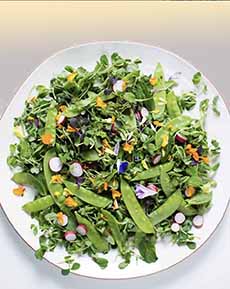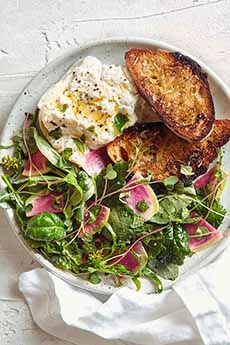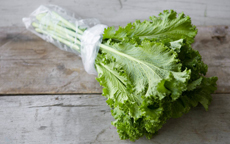|
Does the spring salad recipe in photo #1 look complicated? It couldn’t be easier. So start your celebration of spring with a lively spring salad. Photo #1 is a simple mixture of:
Pea shoots (photo #2), a fleeting spring treat
Fresh mint
Baby radishes
Snow peas
Edible flower petals
Vinaigrette of EVOO and fresh lemon juice
You can top the salad with your protein of choice to make it a main course. Photo #3 features a poached egg—plus lots of Périgord black truffles* (for those with deep pockets).
> The history of salad.
WHAT MAKES IT A “SPRING SALAD?”
What makes a salad a “spring” salad?
It’s tender, has a splash of color beyond green, and uses ingredients that come into season in spring, delivering something beyond wwinter’s mix of celery, cucumbers, carrots, iceberg and romaine lettuces, mushrooms, onions, and Red Globe radishes. These include:
Asparagus
Boston/butterhead lettuce
Fiddlehead ferns
Garlic scapes
Delicate herbs (chives, dill, parsley)
Mustard greens (photos #7 and #8)
Pea shoots, greens, and green peas
Ramps
Red leaf lettuce
Watercress…
..and much more. (Other harbingers of spring such as morel mushrooms and nettles must be cooked.)
> Check out this list of spring vegetables and fruits.
In the “olden days” prior to the 1970s or thereabouts, produce was seasonal. Green peas were the products of spring, as were asparagus, green beans, and other items on the spring produce list.
Now, in-demand produce is available year-round, whether greenhouse-grown or imported from the Southern Hemisphere, where the seasons are opposite ours (carbon miles be damned).
WHAT’S A SPRING MIX SALAD
You may have noticed in the packaged salad section of your produce department a blend called “spring mix.”
In general, a spring mix usually contains tender baby lettuces and baby spinach. It may also include red and green romaine, red and green oak leaf lettuce, other heirloom lettuces, chard, arugula, endive, and radicchio.
Spring mix is normally harvested at a very young age, while the greens are still small and tender [source].
MORE SPRING SALAD INGREDIENTS
Don’t hesitate to try something new. If you’re a fan of spring peas, you’ll be delighted by the taste of pea shoots (photo #4), pea greens, and pea blossoms.
The best place to find exciting ingredients is a farmers market, followed by a specialty produce store.
Asparagus
Baby arugula
Baby lettuces (butter lettuce [Boston lettuce] and bronze or red oak leaf lettuce)
Other baby greens, including spinach
Beets: red, orange and yellow (choose two colors, or substitute striped chioggia beets, photo #5)
Capberberries†
Chard
Chives
Dandelion greens (photo #5)‡
Escarole
Microgreens
Pea shoots (photo #2) and pea greens
Watercress
Optional garnish: capers, croutons
Radish: look for specialty radishes, e.g. breakfash radish, watermelon radish (photo #4)
10 MORE SPRING SALAD RECIPES
Basil Vinaigrette
Blood Orange Vinaigrette
Meyer Lemon Vinaigrette
Smoked Salmon With Spring Salad
Spring Panzanella Salad (bread salad)
Spring Potato Salad
Spring Salad: Asparagus & Radishes
Spring Salad Bouquet
Spring Salad With Burrata Cheese
Spring Salad With Warm Bagna Cauda Dressing
________________
*There are only winter and summer truffles. Here’s more about them.
†While capers and caperberries are plucked from the bush beginning in May, they are typically pickled and thus available year-round. They go so well with fish and spring produce.
‡Dandelion greens are actually a weed, but one that packs in lots of vitamins and minerals (a great source of vitamins A, C, and K, calcium, folate, and potassium). They may be the most nutritionally dense green you can eat, outstripping kale and spinach.
Dandelion greens have a potent flavor that mellows when cooked. They can be eaten raw, braised, steamed, and used in place of spinach [source].
|
|

[1] Spring salad #1: pea shoots, mint, snow peas and more (photo © California Olive Ranch).

[2] Pea shoots, a fleeting gift from Mother Nature (photo © Sid Wainer & Sons).

[3] Spring salad #2: Romanesco broccoli, zucchini, pea shoots, baby greens, poached egg and garnish of Perigord truffles* (photo © D & D Restaurants | London).

[4] For breakfast or lunch, spring salad #3, with watermelon radishes and burrata. That’s a drizzle of EVOO on the burrata. You can substitute a poached egg. Here’s the recipe (photo © Good Eggs).

[5] The bright striped circles are chioggia beets (photo © Fosters Market Cookbook).

[6] Dandelion greens are a spring treat. There’s more about them in the footnote‡ (photo © Good Eggs).

[7] Mustard greens are members of the cancer-fighting Brassica genus (photos #7 and #8 © Good Eggs).

[8] You may be lucky and come across red mustard greens. They’ll add color to your salad.
|







